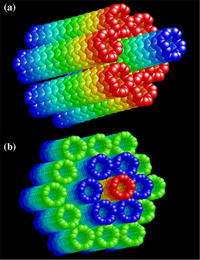Nanotube bundles could be used as motors for nanodevices

Even the smallest devices, assembled at the molecular level, need motors and oscillators. UC Riverside Mechanical Engineering Professor Qing Jiang thinks bundling groups of carbon nanotubes together could make an ultra-efficient and accurate nano-oscillator.
His findings were published in the in the May 14 issue of the Institute of Physics journal, Nanotechnology, in a paper titled Nanotube Oscillator Based on a Short Single-Walled Carbon Nanotube Bundle, co-authored with colleagues Jeon Won Kang, Ki Oh Song and Ho Jun Hwang from Chung-Ang University, Seoul, South Korea.
In the rapidly developing field of nanotechnology – doing things at a scale 100,000 times narrower than a human hair – nanodevices are becoming an increasingly key component in everything from drug delivery to improving or even replacing the microprocessors in computers or optical switches in telecommunications networks.
“We’re looking at the very fundamentals of machinery in the nanoscopic world and what it takes to move the components of these machines, ultra-fast, super-efficient and with extreme precision” Jiang said. “A nano-motor generating rotational motion, a nano-oscillator (like a piston) generating linear motion forward and backward. We’re looking at how best to generate these motions in a nano-environment.”
Jiang’s earlier work, done mostly with multi-walled carbon nanotube oscillators, in which a narrow nanotube is encased in a larger nanotube, encountered two limitations – frequency and friction. With increased frequency, beyond the benchmark one gigahertz (a billion cycles per second), increased energy dissipation creates a lot of heat, which reduces the efficiency of the tiny pistons.
His current work, with bundles of single-walled carbon nanotubes encased in an additional layer of single-walled carbon nanotubes outperformed their multi-walled counterparts and generated less heat and friction problems.
“We were very encouraged by the findings of this paper and think we may be on our way to developing efficient oscillators,” Jiang said.
However, Jiang and his colleagues plan on exploring new substances that could better address the friction and heat limitations that carbon nanotubes encounter.
Source: University of California, Riverside




















